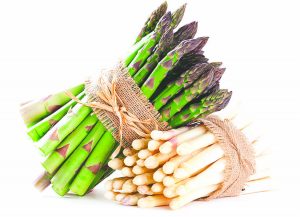Home cooking: Asparagus is delicious way to celebrate spring
By Angela Shelf Medearis — March 26, 2020During a visit to Germany, I was introduced to all things asparagus. Nothing says spring is here in Germany like a beautiful bunch of crisp, white asparagus, or as they call it, Spargel! The white variety of asparagus is harvested in Germany from about mid-April to June 24, which is known as St. John the Baptist Day. Rich in nutrients and very low in calories, asparagus has become a culinary status symbol for many Germans.
According to the website, germanfood.org, it takes three years for an asparagus plant to produce its first tip. For white asparagus, soil is piled into knee-high banks, which give the fields their characteristic appearance. White asparagus grows best in sandy soil surrounded by mounds of earth, which protects the slender stalks from sunlight exposure and keeps them from turning green. This also affects the subtle flavor of the vegetable.
From Baden-Wurttemberg to Brandenburg, certain rural areas in Germany take special pride in being prime asparagus growing regions. Four states are even home to scenic “Asparagus Routes,” which have created an asparagus tasting tourism.
Green varieties of asparagus are more popular in America and are available year-round. Asparagus is easy to select and to prepare and comes in a variety of vibrant colors, including green, violet, purple and white. Asparagus also grows wild and is commercially available fresh, frozen and canned. Various types and colors of asparagus can be used without any noticeable difference in the taste, so mix and match colors and sizes for visual interest.
Asparagus should be crisp and firm, not limp or wrinkled, with tightly closed tips. Dull colors and ridges in the stems are an indication of a lack of freshness. The stalks should not be limp or dry at the cut and of uniform thickness.
If you’re planning to use the asparagus on the same day, rinse it under cool water, pat the stalks dry with a paper towel. Smaller stalks can be broken or cut at the point where the stem naturally snaps. Peeling the end of thicker stalks with a paring knife or a vegetable peeler removes any woody stems and can be done up to two hours before cooking. Place the prepared asparagus in a plastic bag in the refrigerator to stay crisp until ready to cook.
Fresh asparagus should never be washed or soaked before storing. If the asparagus is bound with a rubber band, remove it, as it will pinch and bruise the stalks. Asparagus can be stored for up to two days if the stalks are trimmed and placed upright in a jar with about an inch of water in the bottom. Cover the asparagus with a plastic bag and store the spears in the refrigerator.
Asparagus is also a nutritional powerhouse. One half-cup of cooked asparagus contains significant amounts of folic acid, vitamin C, potassium and beta-carotene. It’s also a heart-healthy food, and a natural diuretic.
This versatile vegetable works well as a room-temperature appetizer, blended into a soup, as the main ingredient in a colorful salad, a flavorful side dish or as part of a main course like my recipe for Asparagus With Fusilli Pasta and Peas. Preparing asparagus is a delicious and nutritious way to celebrate spring.
ASPARAGUS WITH FUSILLI PASTA AND PEAS
12 ounces fusilli pasta (or penne or farfalle)
1 pound asparagus, white, green, purple or violet or a mixture
4 ounces sugar snap peas
1 cup frozen peas
1 1/2 tablespoons olive oil
3/4 cup minced onions (1/2 large white onion)
2 tablespoons Italian seasoning
1 teaspoon salt
1 teaspoon ground black pepper
1/8 teaspoon red pepper flakes or cayenne pepper
2 cups chicken broth
1 1/2 teaspoons grated lemon zest
1 1/2 cups grated Parmesan or Romano cheese, plus more for sprinkling
- Bring a 5- to 6-quart pot of heavily salted water to a boil. Add pasta and cook as package directs. Add asparagus and sugar snap peas about 3 minutes before the recommended time for the pasta to be done. Add frozen peas 2 minutes before the recommended time for the pasta to be done.
- Drain pasta and vegetable mixture, reserving 1 cup of the pasta water. Return pasta and vegetable mixture to pasta pot.
- While pasta cooks, heat oil in a 10- to 12-inch nonstick skillet over medium heat. Add onions, Italian seasoning, salt, pepper and red pepper flakes or cayenne. Saute 5 minutes until tender. Add broth and simmer 2 to 3 minutes.
- Add onion mixture and lemon zest; gently toss to mix and coat the pasta. Toss with 1 cup of the Parmesan and 1/2 cup of the pasta water, as needed, to create a sauce that coats the pasta. Use the rest of the cheese to sprinkle on pasta. Serves 4.
***
Angela Shelf Medearis is an award-winning children’s author, culinary historian and the author of seven cookbooks. Her new cookbook is “The Kitchen Diva’s Diabetic Cookbook.” Her website is www.divapro.com. To see how-to videos, recipes and much, much more, Like Angela Shelf Medearis, The Kitchen Diva! on Facebook. Recipes may not be reprinted without permission from Angela Shelf Medearis.
© 2020 King Features Synd., Inc., and Angela Shelf Medearis








